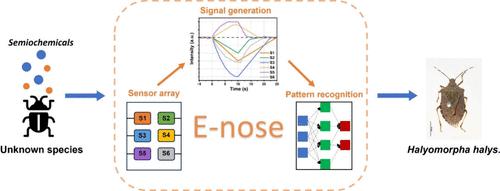Our official English website, www.x-mol.net, welcomes your
feedback! (Note: you will need to create a separate account there.)
Non-Destructive Pest Detection: Innovations and Challenges in Sensing Airborne Semiochemicals
ACS Sensors ( IF 8.2 ) Pub Date : 2024-11-07 , DOI: 10.1021/acssensors.4c02049 Ming Chen, Maryam Yazdani, Krishnan Murugappan
ACS Sensors ( IF 8.2 ) Pub Date : 2024-11-07 , DOI: 10.1021/acssensors.4c02049 Ming Chen, Maryam Yazdani, Krishnan Murugappan

|
Pests, especially invasive ones, pose significant threats to the global ecosystem, crop security, and agriculture economy. Sensing airborne semiochemicals as a nondestructive detection method has been recognized as a promising strategy to detect the presence of these living pests on site. However, sensing airborne semiochemicals in fields is challenging, as they are transmitted in concentrations as low as several nanograms per cubic meter in chemically diverse environments. This low vapor pressure together with similarity in functional groups of pheromones among different species have curtailed the practical deployment of corresponding sensors for real world applications. This review describes the advances in semiochemical detection methods and technologies including traditional analytical instruments, trained animals, and electroantennography with a focus on electronic noses (e-noses). Several key types of volatile organic compound (VOC) sensors used in e-noses are summarized, including their transduction methods, sensing materials, and sensing performance for semiochemical and simulants detection. Notably, it was found that many commercial VOC sensors failed to respond to airborne semiochemicals effectively, leading to a reduced efficiency of e-noses. Future work may focus on developing stable and robust sensing materials with higher sensitivity and selectivity to pheromones and understanding the feasibility of the deployment of the sensors under field conditions.
中文翻译:

无损害虫检测:传感空气中的半导体化学品的创新和挑战
害虫,尤其是入侵性害虫,对全球生态系统、作物安全和农业经济构成重大威胁。传感空气中的半化学物质作为一种无损检测方法,已被公认为一种很有前途的策略,可以检测现场是否存在这些活害虫。然而,在田间检测空气中的半化学物质具有挑战性,因为它们在化学成分不同的环境中以低至每立方米几纳克的浓度传输。这种低蒸气压以及不同物种之间信息素官能团的相似性限制了相应传感器在实际应用中的实际部署。本文综述了半化学检测方法和技术的进展,包括传统分析仪器、训练有素的动物和电图,重点是电子鼻 (e-noses)。总结了用于电子鼻的几种关键类型的挥发性有机化合物 (VOC) 传感器,包括它们的转导方法、传感材料以及用于半化学和模拟物检测的传感性能。值得注意的是,研究发现许多商用 VOC 传感器无法有效响应空气中的半导体化学物质,导致电子鼻的效率降低。未来的工作可能侧重于开发对信息素具有更高灵敏度和选择性的稳定而坚固的传感材料,并了解在现场条件下部署传感器的可行性。
更新日期:2024-11-08
中文翻译:

无损害虫检测:传感空气中的半导体化学品的创新和挑战
害虫,尤其是入侵性害虫,对全球生态系统、作物安全和农业经济构成重大威胁。传感空气中的半化学物质作为一种无损检测方法,已被公认为一种很有前途的策略,可以检测现场是否存在这些活害虫。然而,在田间检测空气中的半化学物质具有挑战性,因为它们在化学成分不同的环境中以低至每立方米几纳克的浓度传输。这种低蒸气压以及不同物种之间信息素官能团的相似性限制了相应传感器在实际应用中的实际部署。本文综述了半化学检测方法和技术的进展,包括传统分析仪器、训练有素的动物和电图,重点是电子鼻 (e-noses)。总结了用于电子鼻的几种关键类型的挥发性有机化合物 (VOC) 传感器,包括它们的转导方法、传感材料以及用于半化学和模拟物检测的传感性能。值得注意的是,研究发现许多商用 VOC 传感器无法有效响应空气中的半导体化学物质,导致电子鼻的效率降低。未来的工作可能侧重于开发对信息素具有更高灵敏度和选择性的稳定而坚固的传感材料,并了解在现场条件下部署传感器的可行性。


















































 京公网安备 11010802027423号
京公网安备 11010802027423号